Foxconn MARS: God of War Performance?
by Gary Key on September 21, 2007 12:00 PM EST- Posted in
- Motherboards
Memory Testing and Overclocking
The Foxconn MARS has the best latency scores of our test units, but the Sandra unbuffered scores are around 2% lower than the ASUS and Gigabyte boards. Foxconn sets very aggressive performance level settings in their current BIOS along with slightly looser sub-timings than the other boards.
Q6600 9x266:
Q6600 9x435:
Q6600 8x490:
In the Q6600 overclocking results, the top screenshot is the system running on the 266 strap with a final 9x435 setting with the CPU at 3.914GHz and memory at DDR2-1086. The bottom screenshot is on the 333 strap resulting in a final 9x480 setting with the CPU at 3.918GHz and memory at DDR2-979. We will go over the performance results in a separate overclocking article once the BIOS is final. Our opinion continues to be that tight chipset and memory latencies are better than FSB wars at the expense of performance. Having both would be ideal but it is very difficult to attain at this point, particularly with quad-core CPUs.
Running the CPU on the lower strap with increased memory throughput results in improvements of latency at 14% and reads at 4%; however, write performance favors the 8x490 setup by 12%. Application results favor the 9x435 setting due to better latencies and throughput. Both settings require the same voltages with the CPU at 1.4875V, Northbridge at 1.898V, CPU VTT at 1.575V, and memory at 2.340V. Vdroop was excellent with an average drop around .02V~.04V with this particular CPU. We have seen Vdrop/Vdroops as high as .06V with our QX6850.
E6550 7x495:
We were able to reach a final FSB setting of 495 with our E6550. The MARS board seems to be limited to around 450FSB when running the 266 (QDR-1066) strap at this time unless you really loosen up the memory timings. However, setting 5-5-5-15 on the memory at 1:1 ratio will result in the board setting performance level (Read Delay) to 9, just the opposite of what we usually see. On this board, the lower the CAS setting, the lower the BIOS will automatically set the performance level while at the same time increasing memory sub-timings. Of course, this is a balancing act that Foxconn engineering is still working on, but the P.03 BIOS we are using is representative of what should be the shipping BIOS. Our E6400 reached a final FSB setting of 520. We were unable to reach the advertised 575FSB that Foxconn has shown. Any attempt to boot the board past 530FSB resulted in three beeps and a return to stock settings.
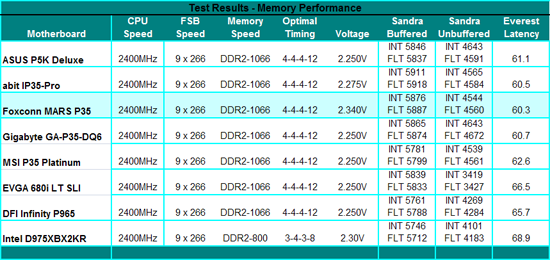 |
The Foxconn MARS has the best latency scores of our test units, but the Sandra unbuffered scores are around 2% lower than the ASUS and Gigabyte boards. Foxconn sets very aggressive performance level settings in their current BIOS along with slightly looser sub-timings than the other boards.
Q6600 9x266:
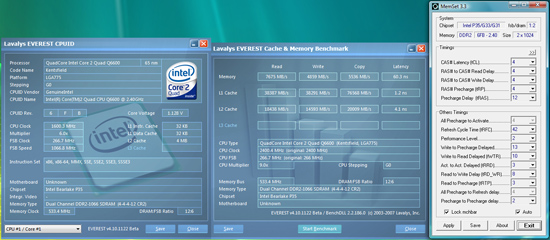 |
Q6600 9x435:
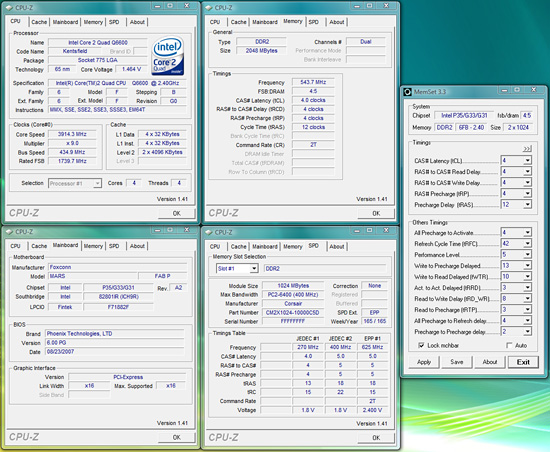 |
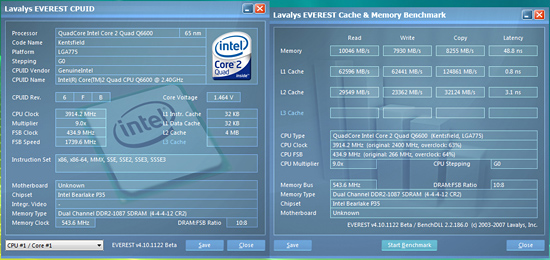 |
Q6600 8x490:
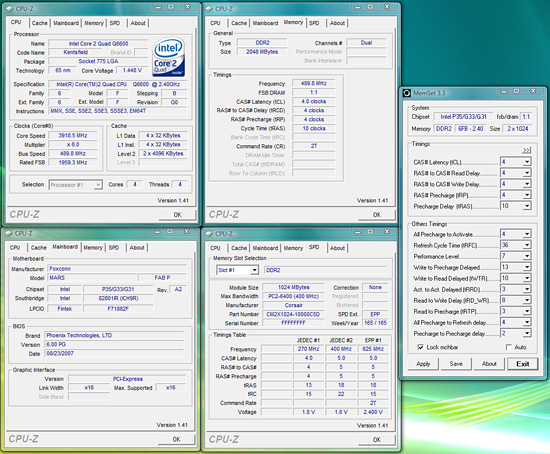 |
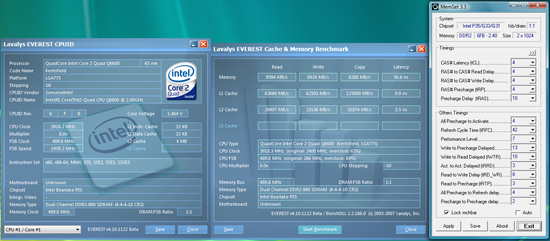 |
In the Q6600 overclocking results, the top screenshot is the system running on the 266 strap with a final 9x435 setting with the CPU at 3.914GHz and memory at DDR2-1086. The bottom screenshot is on the 333 strap resulting in a final 9x480 setting with the CPU at 3.918GHz and memory at DDR2-979. We will go over the performance results in a separate overclocking article once the BIOS is final. Our opinion continues to be that tight chipset and memory latencies are better than FSB wars at the expense of performance. Having both would be ideal but it is very difficult to attain at this point, particularly with quad-core CPUs.
Running the CPU on the lower strap with increased memory throughput results in improvements of latency at 14% and reads at 4%; however, write performance favors the 8x490 setup by 12%. Application results favor the 9x435 setting due to better latencies and throughput. Both settings require the same voltages with the CPU at 1.4875V, Northbridge at 1.898V, CPU VTT at 1.575V, and memory at 2.340V. Vdroop was excellent with an average drop around .02V~.04V with this particular CPU. We have seen Vdrop/Vdroops as high as .06V with our QX6850.
E6550 7x495:
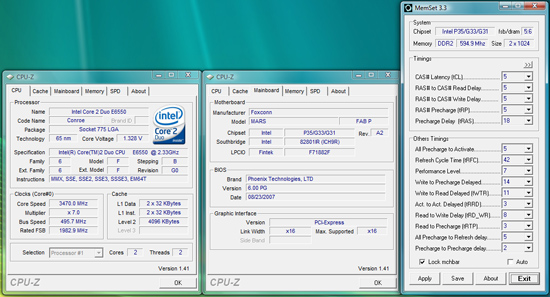 |
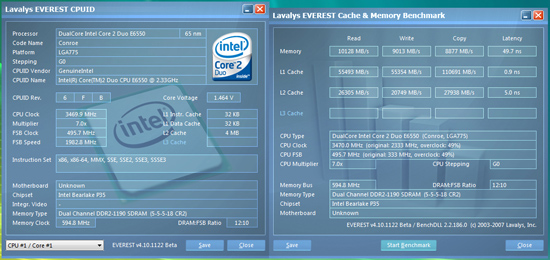 |
We were able to reach a final FSB setting of 495 with our E6550. The MARS board seems to be limited to around 450FSB when running the 266 (QDR-1066) strap at this time unless you really loosen up the memory timings. However, setting 5-5-5-15 on the memory at 1:1 ratio will result in the board setting performance level (Read Delay) to 9, just the opposite of what we usually see. On this board, the lower the CAS setting, the lower the BIOS will automatically set the performance level while at the same time increasing memory sub-timings. Of course, this is a balancing act that Foxconn engineering is still working on, but the P.03 BIOS we are using is representative of what should be the shipping BIOS. Our E6400 reached a final FSB setting of 520. We were unable to reach the advertised 575FSB that Foxconn has shown. Any attempt to boot the board past 530FSB resulted in three beeps and a return to stock settings.










17 Comments
View All Comments
Griswold - Sunday, September 23, 2007 - link
I see they also implemented the Northbridge<->PWM section cooling with heatpipes. Recipe for hot PWM with an Overclocked 4 core CPUHumbug. The PWMs with an overclocked quad will be hotter than a P35 NB - and they also can take alot more heat than a NB. Dont make issues up where there are none.
kmmatney - Saturday, September 22, 2007 - link
it seems like it would be better just to remove the covers over chipset heatsinks - don't they just reduce airflow? The coolpipe logo piece should just be taken off altogether.wolfman3k5 - Saturday, September 22, 2007 - link
Nice review, thanks allot! I want to buy one of these, where can I find this board?JarredWalton - Saturday, September 22, 2007 - link
Not out at retail quite yet - early next month I believe.cmdrdredd - Saturday, September 22, 2007 - link
Good board from the review, but it's a little late. Those who were looking to adopt P35 already have one of the other boards, everyone else wants to see X38. I suppose it would depend on the price of this board vs others once it hits actual retail channels.Griswold - Sunday, September 23, 2007 - link
Your world must be really small.strikeback03 - Monday, September 24, 2007 - link
Then again, didn't Gary Key say in the comments on the ASUS X38 board that he expects X38 to take over this market segment once initial hysteria wears off; as performance should be better than P35 for the same money. Then P35 would primarily work in the midrange.